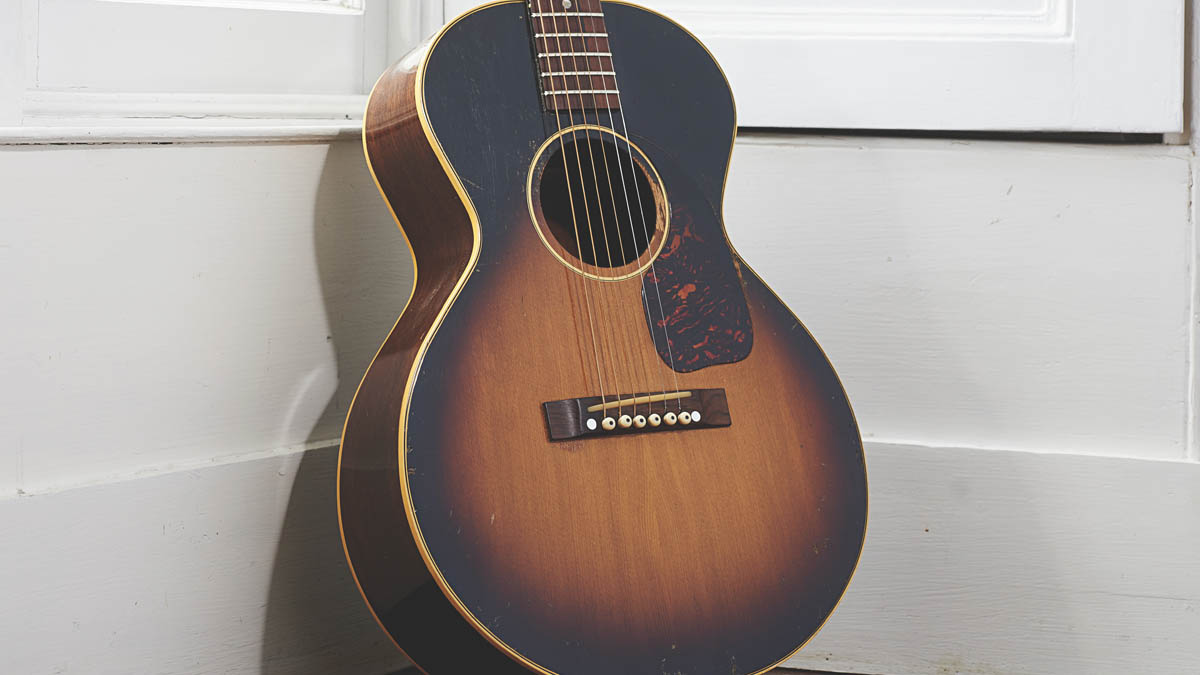How the war effort shaped the history of Gibson acoustics with the LG Series
Introduced during World War II, these small flat-tops were a mix and match of greatness

From the early 1940s, guitar-building materials were in increasingly short supply due to America’s war effort. Furthermore, following President Roosevelt’s formation of the War Production Board, Gibson was forced to turn its attention to the manufacture of military hardware.
These monumental changes may have signalled the end of the Kalamazoo firm had it not been for the immense efforts of the female staff who, against the odds, not only helped keep guitar production going but also happened to create some of the finest flat-tops to ever leave the factory.
Crafted between 1942 and 1946, these revered wartime instruments are often referred to as ‘Banner’ guitars on account of a headstock decal that reads ‘Only a Gibson is good enough’.
Appearing in 1942, the 14¼-inch-wide LG series fleshed out a limited range of wartime flat-tops, which also included the L-00, J-45 and Southerner Jumbo. Many will already be familiar with the LG series model names (LG-0, LG-1, LG-2, LG-2¾ and LG-3), although their appearances, disappearances, reappearances and redesignations has caused much confusion.
Muddying the waters even further is the fact that specifications chopped and changed from one guitar to the next in the early days due to material shortages.
The sunburst LG-2 and its natural-finish equivalent, the LG-3, were both introduced in 1942. As was the sunburst J-45 along with its natural-finish counterpart, the J-50.
However, because of the difficulty in obtaining “good enough” quality tonewood for the plain tops, both the LG-3 and J-50 were temporarily discontinued until after the war (a total of 130 and 144 of each were shipped between ’42 to ’43 respectively). As the sunburst models were able to disguise imperfections in tonewood more easily, Gibson soon began using the finish exclusively.
All the latest guitar news, interviews, lessons, reviews, deals and more, direct to your inbox!
The first LG-1 was shipped in 1943, as was the first Southerner Jumbo. The original incarnation of the LG-1 features X-bracing as per the LG-2 and LG-3. However, unlike its spruce-topped siblings, the Banner LG-1 features a mahogany soundboard; a stain finish further sets it apart.
A mere 139 of these rare LG-1s left the factory – 138 in ’43 and the final one in ’44. When the LG-1 reappeared after the war it did so with a sunburst spruce top. Thus it appears similar to the LG-2, although its budget-end lateral/‘ladder’ bracing provides a more midrange-focused sound.
In 1958, the LG-0 was released as a budget guitar for “students, teachers, strolling players, and anyone who wants to have fun with the guitar”. Like the post-war LG-1, the LG-0 is ladder-braced. It featured an all-mahogany construction until ’68 when a spruce top was fitted as standard (at the same time, the LG-1 was discontinued). While the LG-0 model was aimed at the lower end of the market, it is considered by many players to be a very respectable guitar indeed.
Similarly, the ladder-braced LG-2¾ appeared in 1949 marketed as “ideal for children or players with small hands”. Regardless, this unique Gibson has found favour with many a pro player.
Guitarist Martin Barre of Jethro Tull fame and singer-songwriter Arlo Guthrie – son of the great Woody Guthrie – both used LG-2¾ Gibsons, while Fender and Rickenbacker author Martin Kelly is never too far away from his favourite “kitchen guitar”.
The Evolution of the Gibson LG Series
- August 1942: First LG-2 shipped; first LG-3 shipped; mahogany backs/sides; spruce tops
- April 1943: First LG-1 shipped; all-mahogany
- 1943: LG-3 and LG-1 production suspended; some LG-2s with
- maple backs/mahogany tops
- 1944: Switch from Adirondack to Sitka spruce tops
- 1946: Headstock banner discontinued; LG-1 and LG-3 production recommences
- 1949: LG-2¾ released
- 1958: LG-0 released; all-mahogany; discontinued 1973
- 1962: LG-2, LG-2¾ and LG-3 superseded by B-25, B-25¾ and B-25N respectively
- 1968: B-25¾ and LG-1 discontinued; LG-0 now with spruce top
- 1977: Last B-25 and B-25N models shipped
- Best Gibson acoustic guitars: acoustics for all styles of player
Rod Brakes is a music journalist with an expertise in guitars. Having spent many years at the coalface as a guitar dealer and tech, Rod's more recent work as a writer covering artists, industry pros and gear includes contributions for leading publications and websites such as Guitarist, Total Guitar, Guitar World, Guitar Player and MusicRadar in addition to specialist music books, blogs and social media. He is also a lifelong musician.


